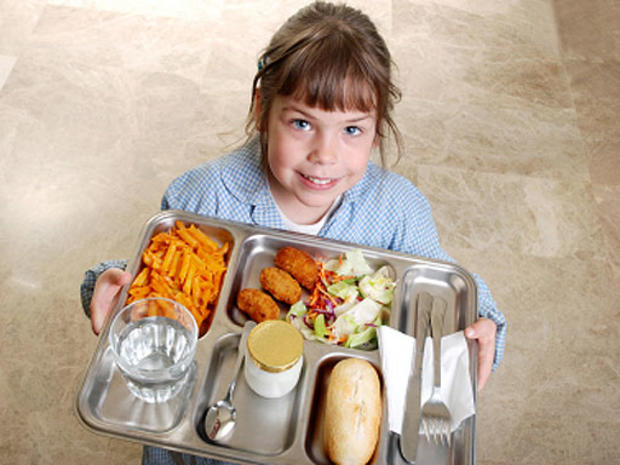Congress pushes back on healthier school lunches
(CBS/AP) What should schoolchildren be fed at school - leafy greens and carrots, or pizza and french fries?
PICTURES: Dr. Oz's 25 health tips for teens
Congress wants pizza and fries to stay on school lunch menus and is fighting efforts by the Obama administration to rid schools of unhealthful food.
The final version of a spending bill released late Monday would unravel school lunch standards proposed earlier this year by the U.S. Agriculture Department (USDA). These include limiting the use of potatoes, putting new restrictions on sodium, and adding more whole grains.
The bill would allow tomato paste on pizzas to count as a vegetable, as it is now. USDA had wanted to count as little as a half-cup of tomato paste to count as a vegetable. A serving of pizza has less than that.
What do nutritionists say? They say the whole effort is reminiscent of the Reagan administration's much-ridiculed cost-cutting effort 30 years ago to classify ketchup as a vegetable. This time around, food companies that make frozen pizzas for schools, the salt industry, and potato growers requested the changes and lobbied Congress.
School meals supported by federal subsidies must include a certain amount of vegetables, and USDA's proposal could have pushed pizza-makers and potato growers out of the school lunch business.
School districts have said some of the USDA proposals go too far and cost too much in an era of tight budgets. Schools have long taken broad instructions from the government on what they can serve in the federally subsidized meals that are given free or at reduced cost to low-income children. But some schools have balked at government attempts to tell them exactly which foods they can't serve.
The school lunch proposal is based on 2009 recommendations by the Institute of Medicine, the health arm of the National Academy of Sciences. Agriculture Secretary Tom Vilsack said they are necessary to curb childhood obesity and future health care costs.
USDA spokeswoman Courtney Rowe said Tuesday that the department will continue its efforts to make lunches healthier.
"While it's unfortunate that some members of Congress continue to put special interests ahead of the health of America's children, USDA remains committed to practical, science-based standards for school meals," she said in a written statement.
Margo Wootan of the Center for Science in the Public Interest said Congress's proposed changes would keep schools from serving a wider array of vegetables. Children already get enough pizza and potatoes, she said. It also would slow efforts to make pizzas - a longtime standby on school lunch lines - healthier, with whole grain crusts and lower sodium levels.
"They are making sure that two of the biggest problems in the school lunch program, pizza and french fries, are untouched," she said.
A group of retired generals advocating for healthier school lunches also criticized the spending bill. The group, called Mission: Readiness, has called poor nutrition in school lunches a national security issue because obesity is the leading medical disqualifier for military service.
"We are outraged that Congress is seriously considering language that would effectively categorize pizza as a vegetable in the school lunch program," Amy Dawson Taggart, the group's director, said in a letter to lawmakers before the final bill was released. "It doesn't take an advanced degree in nutrition to call this a national disgrace."
Specifically, the bill would:
*Block USDA from limiting starchy vegetables, including corn and peas, to two servings a week. The rule was intended to cut down on french fries, which many schools serve daily.
*Allow USDA to count two tablespoons of tomato paste as a vegetable, as it does now. The department had tried to require that only a half-cup of tomato paste could count as a vegetable. Federally subsidized lunches must have a certain number of vegetables to be served.
*Require more study on long-term sodium reduction requirements set forth by the USDA guidelines.
*Require USDA to define "whole grains" before regulating them. The USDA rules require schools to use more whole grains.
Food companies that have fought the USDA standards say they were too strict and neglected the nutrients offered by potatoes, other starchy vegetables and tomato paste.
"This agreement ensures that nutrient-rich vegetables such as potatoes, corn and peas will remain part of a balanced, healthy diet in federally funded school meals and recognizes the significant amounts of potassium, fiber and vitamins A and C provided by tomato paste, ensuring that students may continue to enjoy healthy meals such as pizza and pasta," said Kraig Naasz, president of the American Frozen Food Institute.
What do you think? Should public schools serve healthier fare? Or should school lunch standards be eased?

